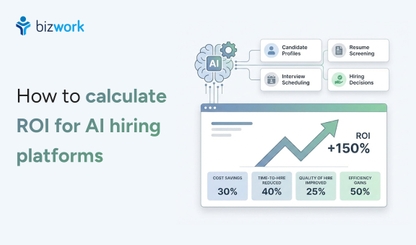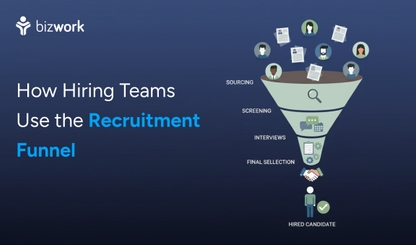Hiring is one of the most crucial yet broken business functions today.
For years, traditional hiring has relied on a cycle where you publish a job description on various platforms, wait for resumes, manually screen them, and conduct interviews. It’s the usual, but also frustratingly slow and costly process. Based on the Global Talent Climate report, it was stated that filling a position takes an average of 44 days, even in fast-moving markets.
It's not only a loss of time but an immense hit on the company’s budget for hiring candidates. According to SHRM, the average cost per hire is around $4,700. That is too much for any beginning company to even afford! The emergence of Artificial Intelligence has touched every industry. 78% of organizations are already using AI in at least one business function.
AI recruitment software are also a hype in HR communities. From resume parsing to candidate engagement, it offers automation, screening, and predictive analytics.
But when should you use AI recruitment software? Or what works best, traditional hiring or AI hiring for your company in 2026?
Let’s find out by comparing AI recruitment software vs traditional hiring, its adoption, and future scope, you should know to make an informed choice.
Traditional Hiring: How It Works & Where It Stands
Traditional recruitment follows a structured but heavily manual path. The most common process in traditional hiring includes the following:
-
Post job listings on boards and company sites.
-
Collect resumes and cover letters.
-
Screen resumes manually for keywords and experiences.
-
Shortlist and schedule interviews.
-
Run multiple interview rounds.
-
Check references, negotiate offers, and finalize.
Strengths
This system has its merits. Human insight allows recruiters to pick up subtle cues during conversations that AI might miss. The benefits of traditional hiring include:
-
Human insight – Recruiters are able to pick up subtle signals during conversations.
-
Cultural judgment – Face-to-face interactions often highlight value alignment.
-
Time-tested – Traditional hiring structure has stood the test of time.
Despite being the OGs of hiring methods, there are various challenges of traditional hiring that can’t go unnoticed.
Limitations
With more inclusion of cultural and value-based assessments, bias, whether conscious or unconscious, often influences decisions in traditional hiring methods. Along with that, it also has limited scalability that doesn’t allow hirers to easily expand talent reach or have a bulk of hiring requirements fulfilled fast.
In today’s fast-moving businesses, this model struggles to deliver the speed and quality companies need, with the following major traditional hiring issues :
-
Long timelines – Average time-to-fill is too long and costly
-
Expensive hires – The Cost of hiring is extremely high when different factors chime in.
-
Unconscious bias – Research confirms hiring decisions are often swayed by names, schools, or backgrounds.
-
Limited reach – Scaling beyond local or regional talent pools is slow without dedicated recruiters.
Traditional hiring still works, but it struggles to keep up with the modern pace of business.
Though how AI recruitment is solving such issues. Let’s find out.
AI Recruitment Software: How It Works & Why It Fits in 2026
Automated hiring software is essentially a digital recruiter that automates repetitive hiring tasks while supporting smarter, data-driven decision-making with the help of artificial intelligence. Some of the core features AI hiring tools brings with this features are.
Strengths
AI hiring software isn’t just automation, it’s a redefined hiring approach that delivers speed, accuracy, and fairness at scale. Benefits of AI in recruitment that brings the key strengths include:
-
AI-powered job descriptions – Generates bias-free, engaging postings tailored for inclusivity.
-
Resume parsing – Instantly scans hundreds of resumes, saving hours of manual effort.
-
Skill-based matching – Prioritizes competencies over job titles, ensuring fairer shortlists.
-
Automated scheduling – Syncs calendars, sets interviews, and updates candidates seamlessly.
-
Predictive analytics – Evaluates potential retention and performance, reducing wrong hires.
-
Compliance tools – Tracks diversity goals and ensures adherence to local hiring laws.
-
Candidate engagement – AI chatbots and automated messages keep applicants informed in real time.
-
Scalability – Processes thousands of applications in minutes, making high-volume hiring effortless.
Limitations
Despite its strengths, Automated hiring software has limitations when not implemented strategically:
-
Training gaps – Recruiters often lack the skills to interpret AI insights effectively.
-
Integration hurdles – AI tools may not sync smoothly with legacy HRIS or ATS systems.
-
Over-reliance risk – Companies sometimes expect AI to replace human judgment, not complement it.
-
Bias in data – AI reflects the quality of data fed into it, which can perpetuate hidden biases.
-
Trust issues – Recruiters and candidates may resist AI-driven decisions without transparency.
-
Compliance challenges – AI must be regularly audited to ensure it meets legal and ethical hiring standards.
In short, Benefits of AI hiring software is no longer a luxury, it’s fast becoming the default. Still if you are confused and wondering what can better fit your company’s requirements.
Pick this quick comparison table for AI vs Traditional recruitment to find the best fit.
Traditional vs AI Hiring: Side-by-Side Comparison
| Dimension | Traditional Hiring | AI Recruitment |
|---|---|---|
| Speed & Efficiency | Avg 44 days to fill roles | Saves ~35% time from avg hiring cycle |
| Candidate Experience | Long waits, poor communication | Chatbots, real-time updates, faster responses |
| Quality of Hire | Relies on recruiter intuition | Data-driven matching, predictive retention |
| Bias & Fairness | Susceptible to unconscious bias | Reduces bias (with oversight) |
| Scalability & Reach | Limited by recruiter bandwidth | Global reach, timezone-smart scheduling |
| Costs | Higher/ candidate | Lower/ candidate |
| Best Fit For | Small teams valuing personal touch, culture-driven hiring | Fast-scaling companies, enterprises, and global hiring needs |
If you have decided to switch to AI hiring methods to avoid the challenges of traditional hiring, then its better you start with the best in the industry.
Top 5 AI Recruitment Automation Tools You Should Know
Recruitment has moved far beyond job boards and spreadsheets. Today, benefits of AI in recruitment tools are reshaping hiring with speed, precision, and scale. Here are five standout AI recruitment automation tools:
1. BizHire
BizHire is an AI recruitment software built for all kinds of hiring. It automates job description creation, resume parsing, smart candidate matching, and timezone-smart interview scheduling. With predictive hiring insights, BizHire not only saves time but also helps companies make better long-term talent decisions.
2. HireVue
HireVue specializes in video interviewing powered by AI. Its platform analyzes candidate responses, tone, and word choice to give structured insights for recruiters. It reduces bias in pre-screening and accelerates large-scale hiring.
3. Pymetrics
Pymetrics takes a neuroscience-based approach to hiring. Candidates play behavioral games that measure traits like risk tolerance and memory. AI then matches results with company success profiles, helping ensure cultural and role alignment.
4. Eightfold AI
Eightfold AI uses deep learning to match candidates with open roles by analyzing billions of profiles. It’s particularly strong in internal mobility, helping organizations redeploy existing talent efficiently while also boosting external hiring.
5. HireEZ
HireEZ focuses on sourcing automation. This automated hiring software uses AI to pull candidates from across the web, enrich profiles with verified data, and automate outreach campaigns. Recruiters get access to a vast, updated talent pool without manual sourcing.
From smarter sourcing to predictive hiring, these AI hiring tools reduce repetitive tasks and empower recruiters to focus on building relationships. AI isn’t replacing hiring—it’s making it sharper, faster, and fairer.
AI Recruitment Adoption Issues & Their Fixes
Even with all its promise, AI recruitment can flop not because the tech fails, but because companies treat it as “just another tool” instead of a transforming migration.
Common Issues
-
Lack of training – Recruiters struggle to interpret AI recommendations, creating doubt and misuse.
-
Integration challenges – Systems don’t always connect smoothly with HRIS or ATS, leading to silos.
-
Over-reliance – Expecting AI to “make the hire” while ignoring human judgment.
-
Trust gap – Recruiters and candidates see AI as a black box, that brings skepticism.
Fixes
-
Strategic mindset – Framing AI as a company-wide change, not a plug-in.
-
Balanced approach – Let AI handle the admin; let humans handle culture and fit.
-
Training – Equip recruiters to understand and trust AI insights.
-
Regular audits – Review algorithms of AI tools for bias, compliance, and fairness.
With the right approach, AI hiring doesn’t just automate tasks it becomes a trusted partner that makes recruitment faster, fairer, and more scalable.
Future Scope: Will AI Replace Recruiters?
Its the biggest question every recruiter worries about these days- Will AI replace recruiters? The answer is no.
Future of hiring with AI is exceptional. Even now AI recruitment software can handle scaling, data, and repetition. Whereas recruiters excel at empathy, persuasion, and cultural alignment.
The future of hiring can become a hybrid model where AI acts as the recruiter’s co-pilot:
-
AI handles the heavy lifting: Sourcing, resume parsing, skills matching, bias-free shortlisting, and predictive analytics.
-
Recruiters handle the human touch: Building relationships, selling the employer brand, aligning values, and making nuanced judgment calls.
Based on Maximise Market Research report, AI Recruitment Market, valued at 661.56 million US dollars already in 2023. By 2030 it is estimated to reach USD 1119.80 Million US dollars showing a phenomenal CAGR of 6.8% over the forecast period.
The future is not ‘AI vs humans’ infact it’s AI + humans, working in partnership to achieve greatest outcomes.
Conclusion
As understood so far, there’s no one-size-fits-all approach to hiring. By deep diving into AI vs traditional recruitment comparison its assessed.
Small companies can benefit from blending AI with traditional recruitment, using automation for efficiency that keeps them stay agile without losing the personal touch.
Whereas for enterprises and large scale companies, AI recruitment software is essential. Scaling globally, managing thousands of applicants, and staying compliant across regions can’t be done manually. Though, the extreme is also not the case.
As, AI isn’t here to replace recruiters, in fact it enhances them. The best hiring models can combine AI’s speed and precision with human empathy and judgment. Together, you can create stronger, more diverse, and future-ready teams.

FAQs
Traditional hiring relies on manual screening, while AI automates tasks like resume parsing and candidate matching.
AI filters applications based on skills and data, minimizing bias from human judgment.
Yes, AI speeds up screening and lowers hiring costs compared to manual methods.
No. AI handles repetitive tasks, but humans are needed for interviews, culture fit, and final decisions.
Tech, healthcare, finance, and high-volume hiring industries gain the most from AI tools.



